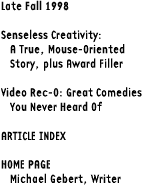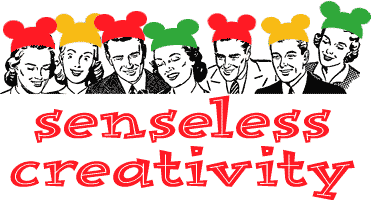


OKAY, THERE'S NO WAY TO DISGUISE THE CLIENT'S NAME in this story: it was Walt Disney World. We were supposed to do a direct mail piece to people who had booked a trip, or people who were about to book one, or something—anyway, people with the pleasant prospect of a trip to Disney World in their immediate future.
And I had the happy little throwaway idea of making miniature Mickey Mouse ear stickers and including them in the package. As if we knew that you were so eager to come to our park that you’d actually stick Mickey ears all over your favorite photos in anticipation. Not many brands could get away with something that presumptuous, but for Disney it hit just the right note, everyone agreed.
So, months later we were actually producing this piece. And an account executive came by to ask me some practical questions about the stickers—how many, what sizes. I answered her questions, but she still seemed puzzled, troubled by something.
Finally she just came out and asked me: “What’s our strategy for these Mouse ears?”
Advertising is a practical art, and any piece of creative that doesn’t have pretty firm roots in a rational strategic purpose is simply self-indulgent. But at the same time, we have to respect the essential mystery of creativity—the fact that at the heart of a piece of creative there is a kind of black hole where rationality breaks down and unpredictable things happen.
An ad can be right on target, but as Duke Ellington said (in words that should be carved over every agency’s door), “It don’t mean a thing if it ain’t got that swing." (All you have to do to prove his point is correct his grammar.) By the same token, something can be hard to reconcile with a literal reading of the strategy—like a taco-lusty chihuahua—and yet somehow be exactly, mysteriously right. (Surely at some point somebody at Taco Bell objected that associating their food with dog food was off strategy—or at the very least, that it cut a little close to home....)
In the end, good creative instincts beat rationality hands down—as Walt Disney himself proved better than anyone. Time and again, he turned his back on some surefire moneymaking formula to pursue his next crazy idea—talkie cartoons, feature-length cartoons, a whole cartoon World. Fortunately for his bankers, his next crazy idea always turned out to be just what the world was waiting for—not that there was any rational way to know that ahead of time.
I looked at that woman for a long time, as I recall, before I finally had an answer for her. “I don’t have a strategy for the Mouse ear stickers,” I said. “There is no rationale behind them. They’re a totally random act of senseless creativity.”
She still didn’t understand. But Walt would have.
Go to my favorite Disney-related website, Yesterland